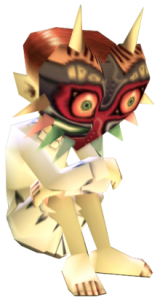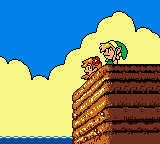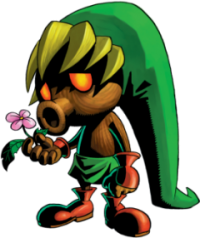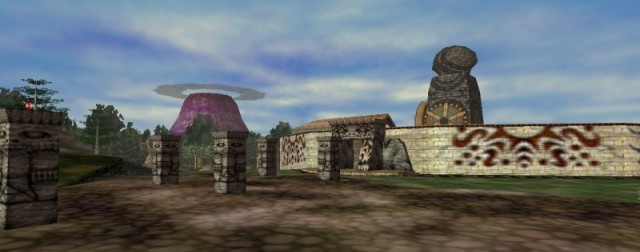Majora’s Mask’s Place in the Zelda Series
Posted on September 21 2012 by Hanyou
 Majora’s Mask is often misconstrued as a dark horse of the Zelda franchise. However it is labeled — “underrated, misunderstood,” etc. — most of these comments simply point toward the misconception that Majora’s Mask isn’t appreciated enough. It came out at the end of a console’s life, after the “wow” factor faded away. Many of the reviews for the game weren’t as positive as those for Ocarina of Time, sometimes for good reasons and sometimes for arbitrary reasons. Likewise, many of the gamers who enjoyed the fairy tale atmosphere of Ocarina of Time, as well as the epic story, might have been initially put off by the radical change of pace in Majora’s Mask.
Majora’s Mask is often misconstrued as a dark horse of the Zelda franchise. However it is labeled — “underrated, misunderstood,” etc. — most of these comments simply point toward the misconception that Majora’s Mask isn’t appreciated enough. It came out at the end of a console’s life, after the “wow” factor faded away. Many of the reviews for the game weren’t as positive as those for Ocarina of Time, sometimes for good reasons and sometimes for arbitrary reasons. Likewise, many of the gamers who enjoyed the fairy tale atmosphere of Ocarina of Time, as well as the epic story, might have been initially put off by the radical change of pace in Majora’s Mask.
But most of them have come around by now, and we live in an era when Nintendo has floated the idea of a Majora’s Mask remake. Whatever the game is, and however it was initially received, it can now safely be said that it is one of the most talked-about and heralded achievements in the Zelda series. It is also a supremely important game, and here’s where it might not get enough credit. After all, it wasn’t as revolutionary as Ocarina of Time, nor was it as representative of Zelda games as a whole. It clearly didn’t have as big of an influence as Ocarina of Time, else we might be seeing more masks and three-day cycles in gaming at large. But many of its underlying ideas are either wholly unique or point towards inevitable future trends in the Zelda series. In hindsight, this much, at least, should be evident.
Ocarina of Time was unquestionably the quintessential Zelda game. It had all the basic elements: Themed dungeons and areas, a three-act story set in two variations of the same world, and a standard villain. It was rightly proclaimed a masterpiece. Viewing Majora’s Mask in light of Ocarina of Time’s success makes the dividing line between the two games even clearer. Majora’s Mask, far from being a standard, definitive Zelda title, deviates so far from whatever standard had been set that it’s almost hard to judge next to Ocarina of Time.
It can be easy to forget that Majora’s Mask is part of an established pattern; we should have seen it coming. The two even-numbered Zelda games at that point had already pushed the series forward into uncharted territory, and placed established, beloved heroes in weird and unfamiliar locations. In a sense, Majora’s Mask was following tradition. Zelda II, a direct sequel to The Legend of Zelda, was so different in such important ways that it has truly become the black sheep of the franchise, if for no other reason than its conventions have not been followed by any canon game. Very little about its gameplay was recognizably Zelda, at least not in accordance with the standard set by the first game. Its story went on a completely different path, choosing to explore an ancient legend that was more complex than the simple save the princess scenario of the first title.
Link’s Awakening was similar. Once again a direct sequel, it was in many ways a parody of every other Zelda game. The setting was tropical and far more vague than the Hyrule we’d been presented with. The story had nothing to do with Ganon, and barely made mention of anything important to Zelda canon. Dungeons progressed in a more linear fashion with more clear-cut direction, and individual characters took center stage to a greater extent. It helped pave the way for Ocarina of Time, but it was also different, and that’s part of its charm.
 Majora’s Mask is another Link’s Awakening. Both take place in bizarre, under-explained worlds. Link’s Awakening offers more explanation for Koholint Island than Majora’s Mask does for Termina, and indeed, Koholint’s nature resides at the center of its story. By the end of the game, it becomes all too clear what happens on the island. In both cases, there is so much beneath the surface that they may just have more substance than their predecessors; they’re deceptive. Both games are more personal, putting Link in the position of arbiter over other characters’ individual lives on a smaller, more focused scale.
Majora’s Mask is another Link’s Awakening. Both take place in bizarre, under-explained worlds. Link’s Awakening offers more explanation for Koholint Island than Majora’s Mask does for Termina, and indeed, Koholint’s nature resides at the center of its story. By the end of the game, it becomes all too clear what happens on the island. In both cases, there is so much beneath the surface that they may just have more substance than their predecessors; they’re deceptive. Both games are more personal, putting Link in the position of arbiter over other characters’ individual lives on a smaller, more focused scale.
Majora’s Mask also has a number of its own ideas, and there are enough in this game to fill several different ones. There is the deep time system, and coupled with it, the save system, which offer new challenges but also new opportunities. There are the masks, which present a messy, unique take on classic Zelda items which is unlike anything else in the Zelda series. And affecting both is the overworld design and sidequest focus.
Odd that such a different game could be such a clear harbinger of the future of its franchise; we should have seen it coming.
Majora’s Mask presents a more superficially linear quest than its predecessors. The idea to allow Link to spend more time in the overworld and less time in the separate dungeons made this, in a sense, more like the 2D games than Ocarina of Time. Whereas Ocarina of Time had a wide open approach to its overworld, with little challenge offered by most of the different regions, Majora’s Mask’s is labyrinthine and consistently challenging. This all comes at a price. Previous Zelda games had more dungeons, and thus offered more “parts” to the main quest. Dungeons are not just there to act as levels; they also help break up the gameplay into different, manageable sections. In earlier Zelda titles, this allows you to explore the overworld at your own pace. Majora’s Mask has four dungeons with four sections of the main quest. This makes for a more linear experience. If you don’t like doing something, it’s harder to drop it in favor of something else.
In Ocarina of Time, for instance, the first three dungeons progress in a linear way. While you can explore Zora’s Domain before completing Dodongo’s Cavern, for the most part, you’re directed through the early parts of the quest. Turn the clock forward seven years, though, and you’re set loose on the world. Last time I played Ocarina of Time, I completed the Fire Temple first, then did the first half of the Water Temple, then the Forest Temple, then the Bottom of the Well, etc. None of this is the “default” way to complete the game, but given the number of dungeons and the variety of each section, Ocarina of Time can feel like a different quest each and every time you play it. Majora’s Mask offered checklists instead. With four major dungeons, each sidequest had to be completed in order, and with the time limit, it was very hard to do anything else at the same time. The effect this had on the game was that of a linear progression. No longer were you free to explore the overworld at your leisure: You were constricted by the clock and the quests. If there was part of a quest you didn’t like, too bad. You had to power through it. I enjoy, for example, taking the eggs back from the Gerudo Pirates, but that particular quest can be so time-consuming, especially without a certain mask, that being forced to power through it can be difficult. While there may be “checkpoints” in such quests where you can turn back time, they’re not always clear, and the overworld still feels a bit more closed off than you might expect.
This is clearly a precursor to modern design decisions in the Zelda series. Arbitrary roadblocks are now put in place so it is actually impossible to progress through the main quest in whatever order you want; the preset order is usually the only way to do things, which can lead to some very tedious moments indeed. In addition, the overworld focus in Majora’s Mask was aided by the four-dungeon scheme, but it has bled into modern games as well. Even with far more dungeons, overworld quests can be long, difficult, and constricting. This was actually a fairly good idea for Majora’s Mask. I was amazed the first time I played Majora’s Mask at how dense the overworld was and how many things there were to do. The sense of tension in that game gave it a unique flavor. Regardless of what you think about subsequent Zelda titles’ insistence on lengthy overworld quests, the fact that some of the fundamental design decisions in Majora’s Mask have so clearly influenced future games in the franchise, specifically Twilight Princess, Phantom Hourglass, Spirit Tracks, and Skyward Sword, means it is more important than it may at first appear. Skyward Sword was touted as the game that brought the dungeon style of gameplay to the overworld, but Majora’s Mask was just as successful at doing the same thing, regardless of the occasional tedium on display. Who can forget the twisting pathways of Ikana Canyon or the ever-increasing challenges of the swamp?
 More obvious is the sidequest focus. The main quest can get tedious, but the sidequests, which were numerous, helped alleviate that somewhat. Majora’s Mask was the first Zelda game to fully develop the idea of a sidquest, not just as a means to an end, but as an end in itself. Masks weren’t always that useful, but at least you had fun getting them. Sidequests here would take much longer than their counterparts in previous games for equal or lesser rewards. In fact, this approach wasn’t all that different from the approach to the main quest, but with sidequests, especially considering that they are optional, the longer, more thorough requirements arguably only made them more fun. Getting Epona back was required, but because it was tied in with character development and led to other sidequests, it didn’t feel like it. While it was exceedingly difficult to do, in the end, it was rewarding, and it offered one of the funner minigames in the 3D Zelda titles. Likewise, the Anju and Kafei quest, which wasn’t required at all, was extremely memorable. Every next step of that quest felt earned, and the reward was simply getting further. It helped enrich the sparsely-explained world and its inhabitants, providing the gamer with precious context. All the while, we got to explore different aspects of the gameplay and take full advantage of the core time system.
More obvious is the sidequest focus. The main quest can get tedious, but the sidequests, which were numerous, helped alleviate that somewhat. Majora’s Mask was the first Zelda game to fully develop the idea of a sidquest, not just as a means to an end, but as an end in itself. Masks weren’t always that useful, but at least you had fun getting them. Sidequests here would take much longer than their counterparts in previous games for equal or lesser rewards. In fact, this approach wasn’t all that different from the approach to the main quest, but with sidequests, especially considering that they are optional, the longer, more thorough requirements arguably only made them more fun. Getting Epona back was required, but because it was tied in with character development and led to other sidequests, it didn’t feel like it. While it was exceedingly difficult to do, in the end, it was rewarding, and it offered one of the funner minigames in the 3D Zelda titles. Likewise, the Anju and Kafei quest, which wasn’t required at all, was extremely memorable. Every next step of that quest felt earned, and the reward was simply getting further. It helped enrich the sparsely-explained world and its inhabitants, providing the gamer with precious context. All the while, we got to explore different aspects of the gameplay and take full advantage of the core time system.
Nothing like this had been done in a Zelda game before. The closest thing was the Biggoron’s Sword quest in Ocarina of Time, but the scale of even medium-sized quests in Majora’s Mask outranks it. After Majora’s Mask was released, games like The Wind Waker and Skyward Sword only continued this trend.
Of course, the importance of the story also cannot be overstated. Not only is Termina unique in the Zelda series, it’s arguably unique in gaming at large. We’re not given much explanation about it, though it certainly calls for an explanation. Games like Myst, which also transport the protagonist to unique worlds, generally explain the origin of those worlds or at least what is going on. Termina itself is a mystery. For anyone who’s played Ocarina of Time, it’s also potentially unsettling, since in terms of canon many of the characters therein already exist.
Majora himself is a rare sort of villain, and he also defies explanation. He’s the sort of thing you only see in cosmic horror stories, driven by a force that is so fundamentally different from that of the protagonist and even the weird world around him that the only possible end to their conflict is destruction of one or the other party.
 Sadly, while both the gameplay structure and sidequest focus of Majora’s Mask have had a profound effect on the series at large, the game’s approach of the plot and world hasn’t been seen again. As previously stated, it was arguably a development on Link’s Awakening’s theme — a unique game in its own right — but its villain made it unique even among video games in general. Demise offered an opportunity for another destructive force akin to Majora, but we were presented instead with a predictable precursor to Ganon. Perhaps Majora was best as a unique villain.
Sadly, while both the gameplay structure and sidequest focus of Majora’s Mask have had a profound effect on the series at large, the game’s approach of the plot and world hasn’t been seen again. As previously stated, it was arguably a development on Link’s Awakening’s theme — a unique game in its own right — but its villain made it unique even among video games in general. Demise offered an opportunity for another destructive force akin to Majora, but we were presented instead with a predictable precursor to Ganon. Perhaps Majora was best as a unique villain.
Majora’s Mask is that rare game that manages to carve out its own distinct place in the series that houses it, but still feels absolutely pivotal and influential to that series. Without Majora’s Mask, it’s unlikely we would have the modern Zelda game’s structure or sidequest focus.





